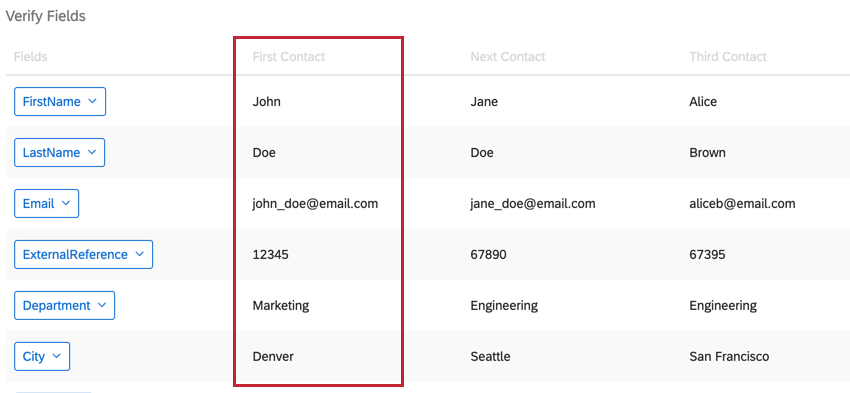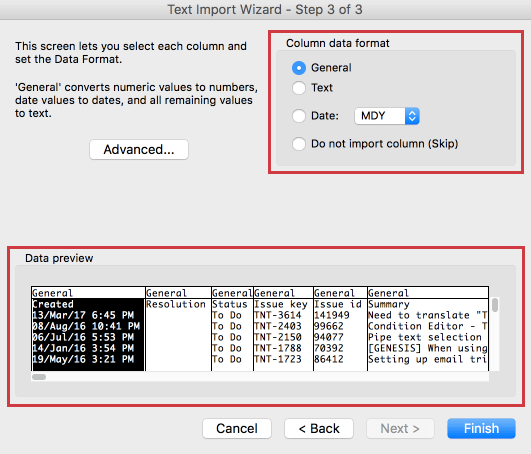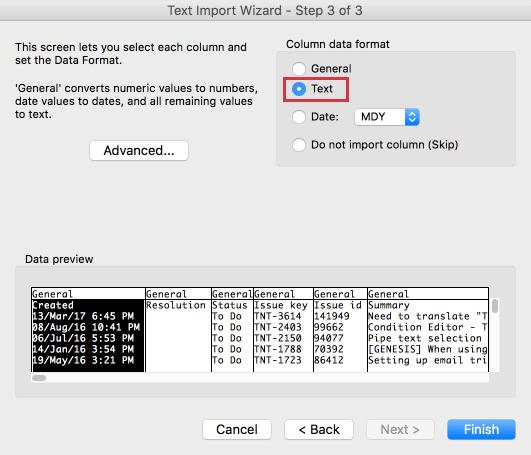CSV & TSV Upload Issues
About CSV/TSV Upload Issues
While CSV files can use either UTF-8 or ASCII encoding, Qualtrics only supports CSV with UTF-8 encoding and TSV. This discrepancy between encoding can sometimes cause issues when importing or exporting data from CSV / TSV files into Qualtrics.
Although there are many places in the platform where CSV / TSV files are used, the most common include:
- Uploading a mailing list
- Importing responses
- Importing files for drill down questions
- Downloading data
- Uploading participants in Employee Experience
This page outlines possible errors that may occur and the steps that can be taken to overcome these issues.
Trouble Importing CSV/TSV Files
There are a few issues that commonly arise when importing files:
- All data displays in the first column, or column breaks are not obeyed correctly when you import the file. This is caused by an incorrect delimiter.
- Special characters are not displaying correctly. In general, “special characters” refers to any symbols or letters except for numbers or the English alphabet.
- The file doesn’t match the standard formatting required.
Incorrect Delimiter Issues
The delimiter is the character that separates fields and values in a spreadsheet file. When the importer does not recognize the correct delimiter, it can read the file in a way that combines columns altogether, or breaks out columns at incorrect intervals. When dealing with an incorrect delimiter, the delimiter setting must be changed.
Example: Below is a possible error message that might occur when importing a contact list with an incorrect delimiter. Notice how all of the information about John Doe is running together, separated only by commas.
We resolve this issue by changing the delimiter to “Comma.” Now notice how John Doe’s information is separated into different fields instead of being bunched together.
Changing Delimiters When Importing Data
When importing data, Qualtrics generally picks a delimiter based on your data file’s format. However, you can follow these steps if you are still having upload issues.
- Navigate to the Import Data menu.
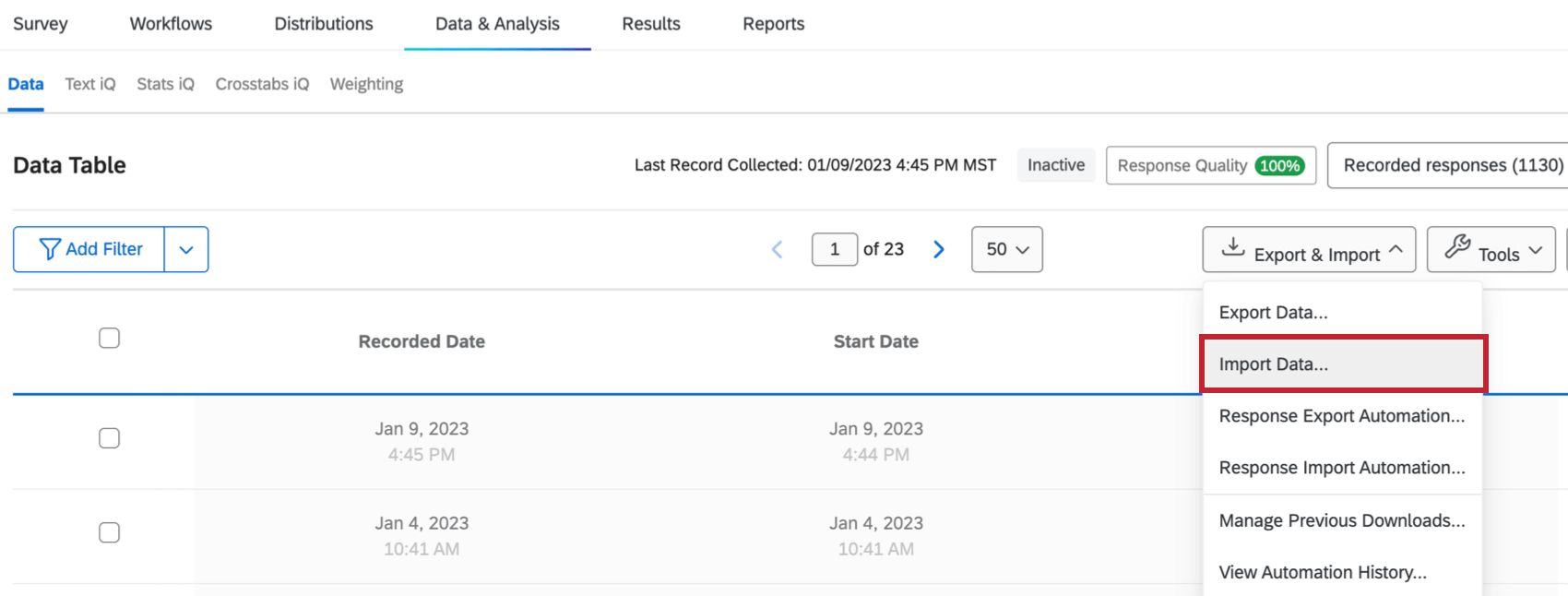
- Click Choose file and select your file.
- Change the Delimiter to Tab (for TSV files) or Comma (for CSV files that are delimited using the , symbol), as required.
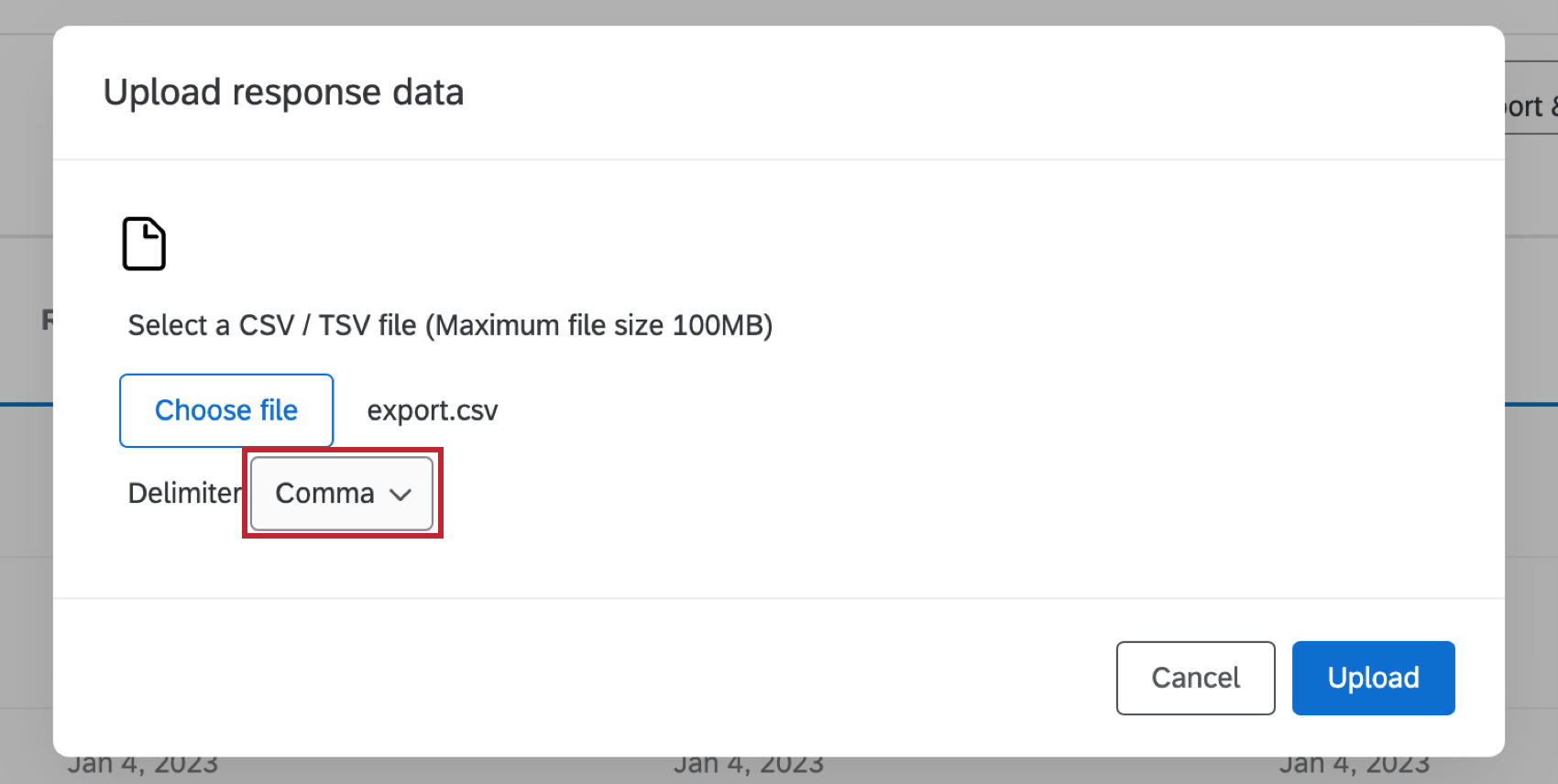
Changing Delimiters When Importing Contacts
- Navigate to the Add list contacts or Create a list menu.
- Select Upload a File.
- Change the Delimiter to Tab (for TSV files) or Semicolon (for CSV files that are delimited using the ; symbol), as required.
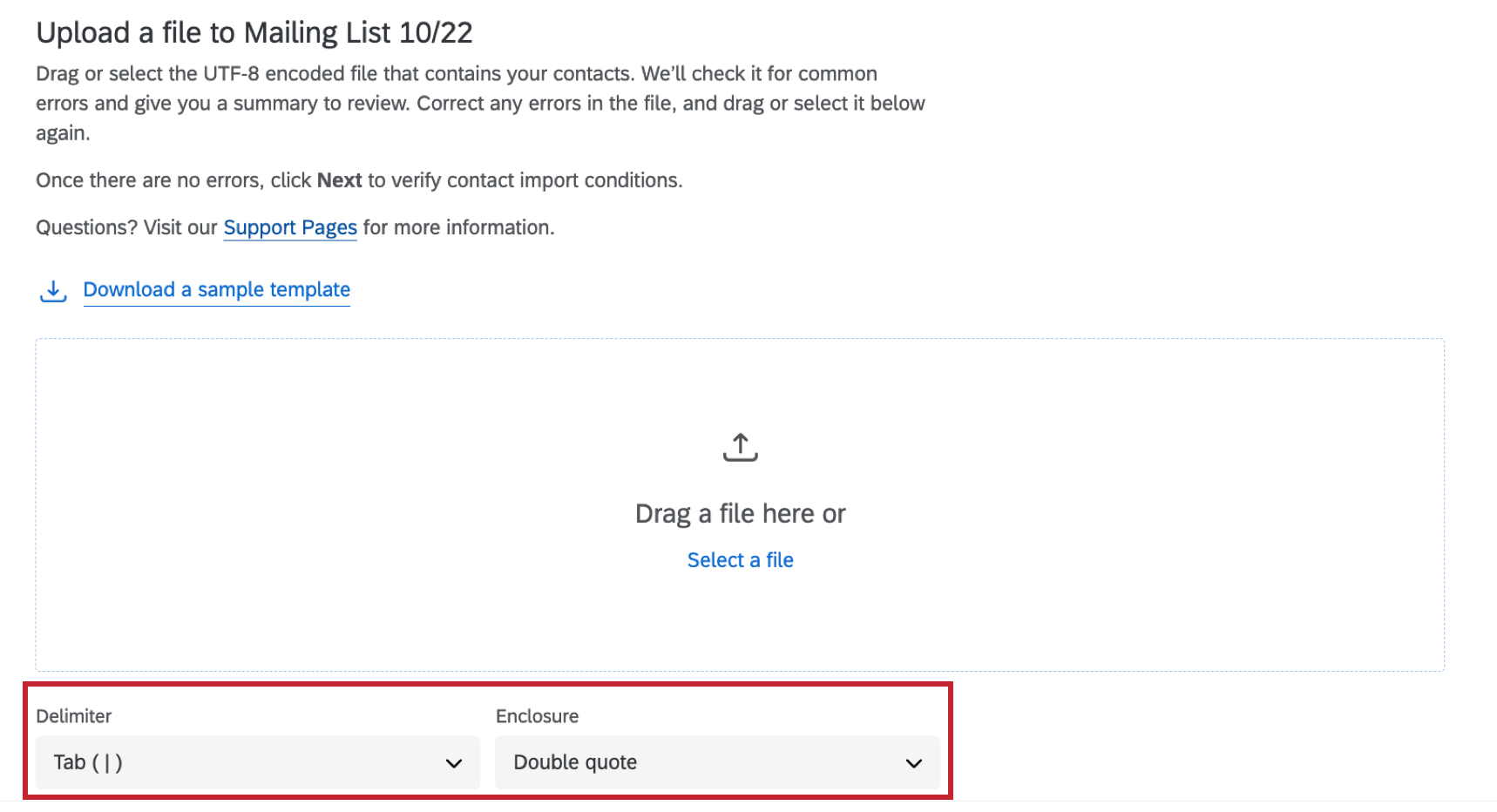
Special Character Issues
When dealing with special character encoding issues, the file type must be changed.
Qualtrics supports UTF-8 encoding for CSV files. This can cause issues with special characters when uploading CSV files from Excel (which defaults to ASCII encoding) into Qualtrics. For example, without reformatting, special characters like 是 or ñ may not show correctly upon import.
Example: Notice how in row 2 and in row 4, the characters’ in these contacts’ names have been replaced with random symbols.
There are 2 possible solutions for issues related to special characters:
Using Microsoft Excel
- Select File and then Save As.
- Change your file type to either Unicode Text (*.txt) if you are using Excel on Windows or CSV UTF-8 (Comma delimited) (.csv) if you are using Excel on Mac.
- Select Save.
- Upload the new file to Qualtrics.
Using Google Sheets
- Import this file to Google Sheets.
- In Google Sheets, select File, then select Download as, and choose Comma-separated values.
- Do not open the file in Excel again.
- Upload the file directly to Qualtrics.
Standard Formatting
Remember, when importing data to any part of Qualtrics, make sure you are following the standard formatting. This means:
- The file is CSV or TSV, not XLS or any other Excel format.
- If the file’s a CSV, it is UTF-8 encoded.
- The headers of the file are correctly formatted.
Header Formatting
Qualtrics will often provide example files right inside the product when you open the importer, which can be used as a reference for importing data. You can also see the following support pages for guidance on how to format the headers, depending on the feature you are using:
Survey Software:
XM Directory:
CX Dashboards:
Employee Experience:
- Importing Hierarchies and other EX Participants
- Importing 360 Participants
- EX Dashboard Translations
- Importing EX Responses
- Importing 360 Responses
- Importing Units
Qtip: This is not the same as creating a hierarchy.
Conjoints:
Please note that not all the features listed above are available in all licenses.
Trouble With Exported CSV Files
If you’re having issues with a CSV file you downloaded from Qualtrics, it may be due to how the file is formatted. There are 2 common issues:
- All data displays in the first column, or column breaks are not obeyed correctly when you import the file. This is caused by an incorrect delimiter.
- Issues with special characters displaying correctly. In general, “special characters” refers to any symbols or letters except for numbers or the English alphabet.
Incorrect Delimiter Issues
- Download your CSV file from Qualtrics. See Exporting Response Data for detailed instructions on downloading survey responses.
Qtip: You can technically download a CSV in many different places in Qualtrics, such as a mailing list or an employee participant list, but downloading response data is the most common example. Note that the pages linked in this Qtip may reference features only available in some licenses.
- Open the file in Excel.
- Select the first column in your spreadsheet.
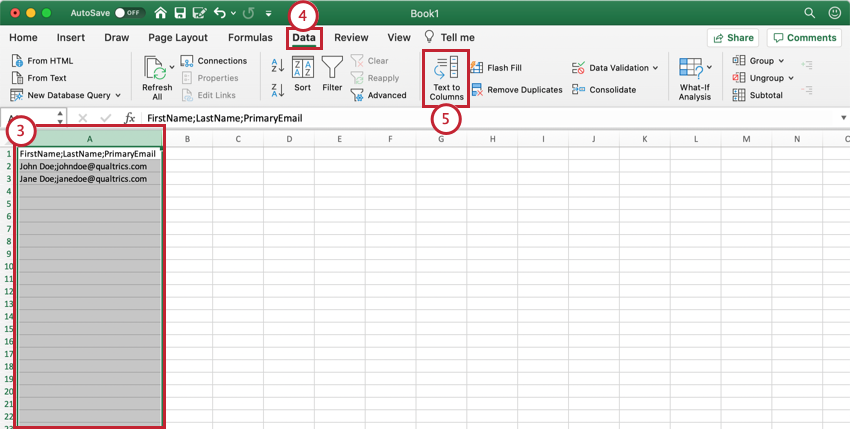
- Select the Data tab.
- Select Text to Columns.
- Choose Delimited and select Next.
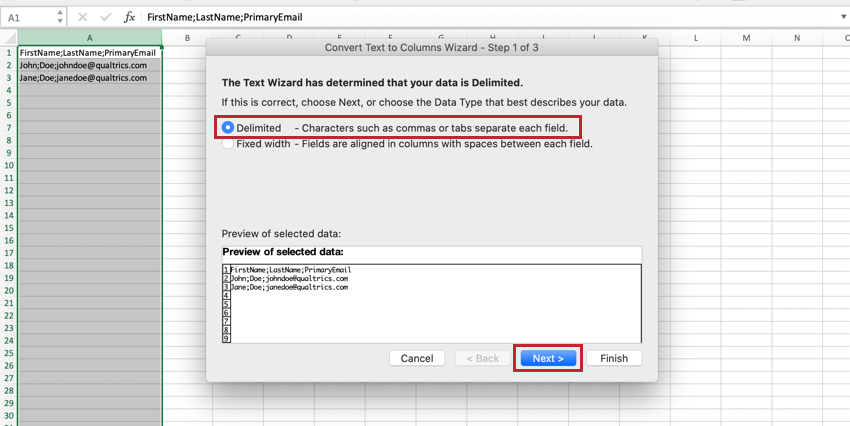
- Change the delimiter value to the value that is being used in the Excel document. In our example, you can see that the data is separated by semicolons, so the delimiter value must be set to Semicolon.
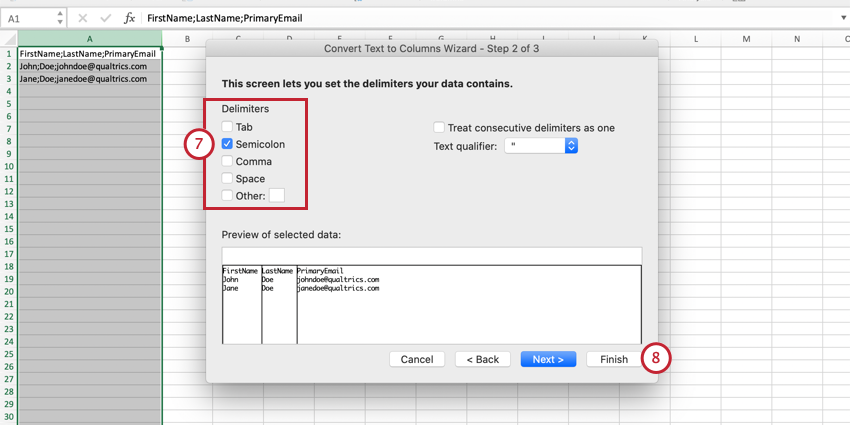
- Select Finish and then continue working with your file as normal.
Special Character Issues
Qualtrics supports UTF-8 encoding for CSV files. This can cause issues with special characters displaying properly when opening CSV files in Excel, which defaults to ASCII encoding.
There are 3 possible solutions for issues relating to special characters:
Using a TSV File
Simply choose the TSV file format when downloading your data from Qualtrics. Qualtrics’ TSV files are UTF-16 encoded, which prevents the problem of special characters not displaying properly. For a guide on how to use TSV files, please see the Opening TSV Files section below.
Using Google Sheets
You can also use Google Sheets to convert your CSV file into an XLS file. This file type is specifically designed for Excel and will open without issue. Please note that XLS files cannot be imported back into Qualtrics.
- Download your CSV file from Qualtrics. See Exporting Response Data for detailed instructions on downloading survey responses.
Qtip: You can technically download a CSV in many different places in Qualtrics, such as a mailing list or an employee participant list, but downloading response data is the most common example. Note that the pages linked in this Qtip may reference features only available in some licenses.
- Open the CSV file in Google Sheets.
- In Google Sheets, save your file as an XLS file.
- Download the file to your computer and proceed as normal in Excel.
Using Microsoft Excel
You can also use Excel to create a UTF-8 encoded file. Follow these steps after downloading your CSV file from Qualtrics.
- Click on the Data tab.
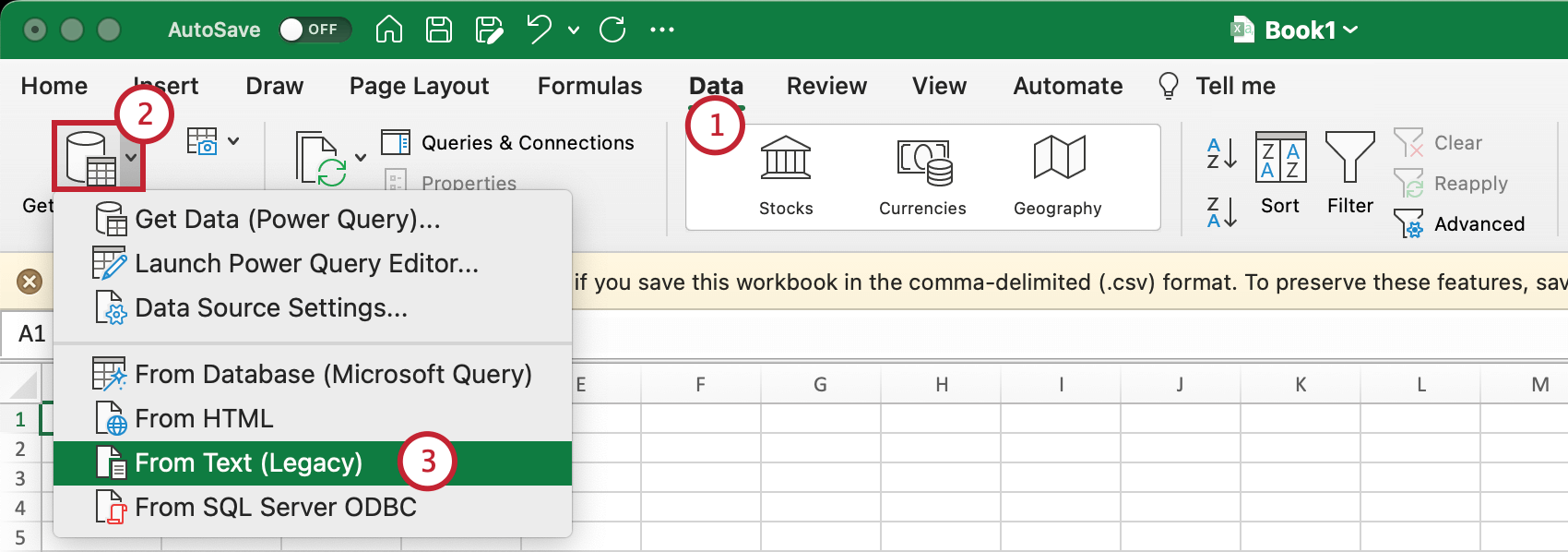
- Select Get Data.
- Choose From Text (Legacy).
- Select the file you downloaded from Qualtrics and click Get Data.
- Choose Delimited.
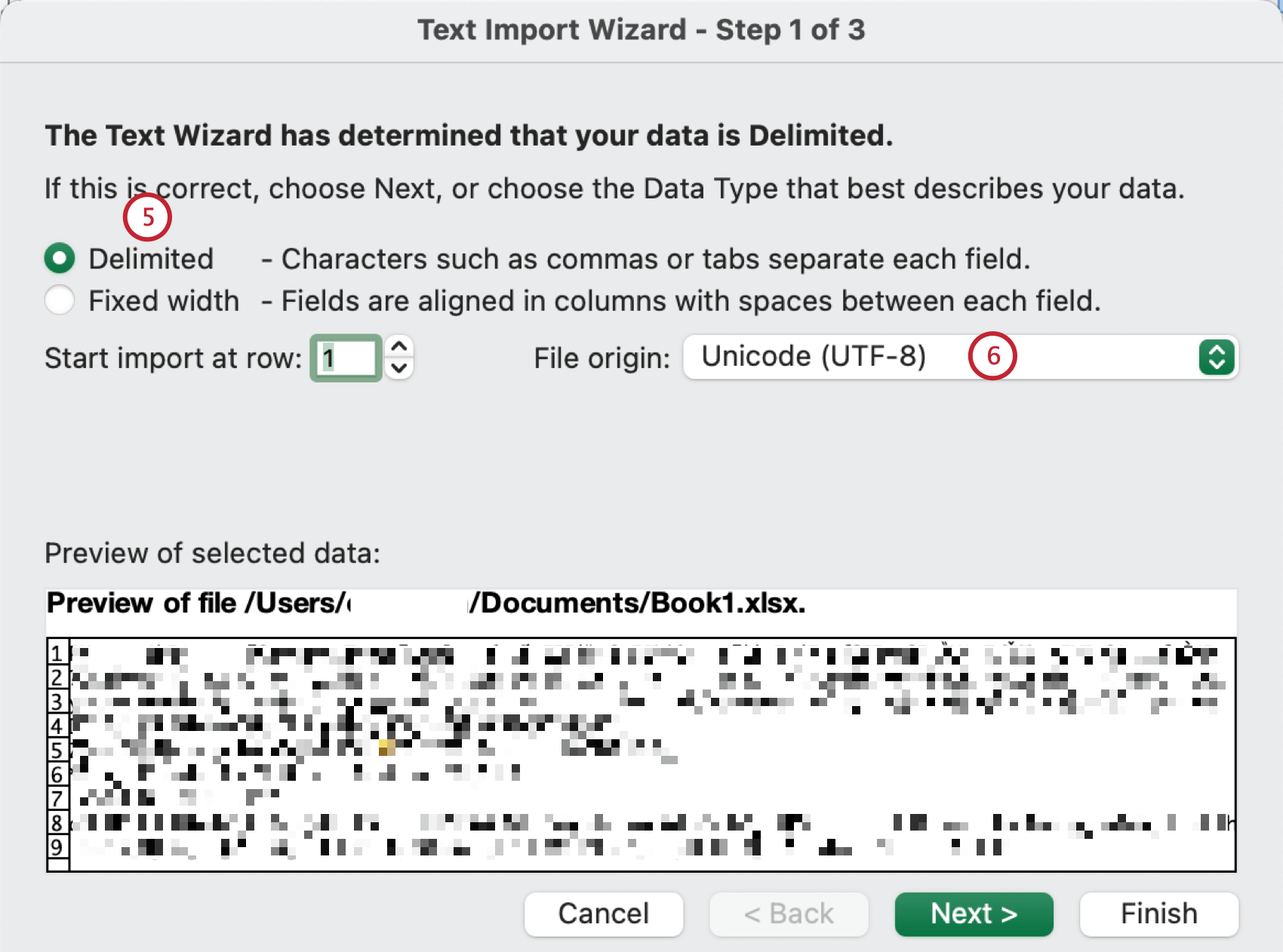
- Select Unicode (UTF-8) for the file origin and click Next.
- Choose Comma as the delimiter and deselect all other options.
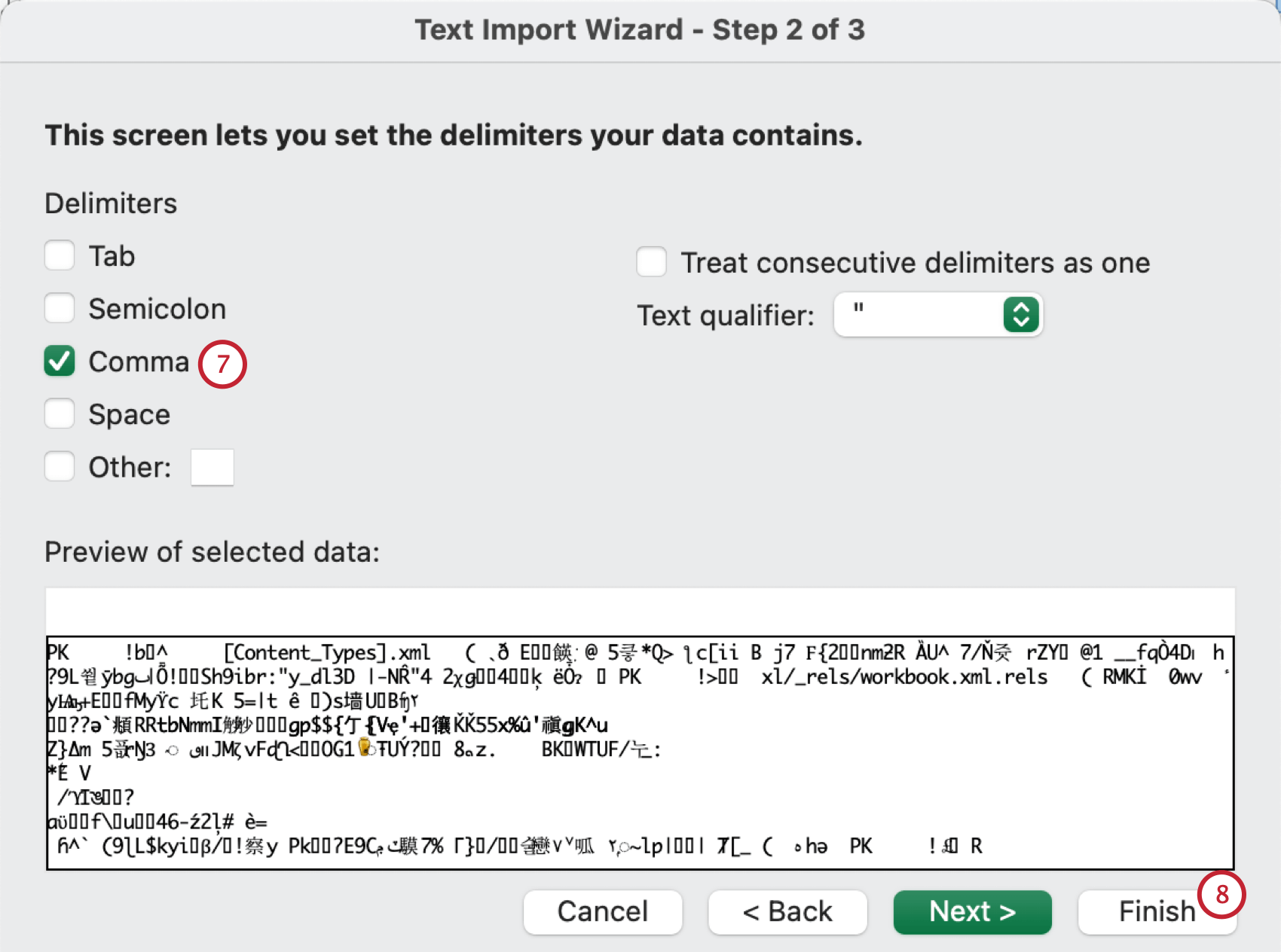
- Click Finish.
- Decide where you want to put the data and select Import.
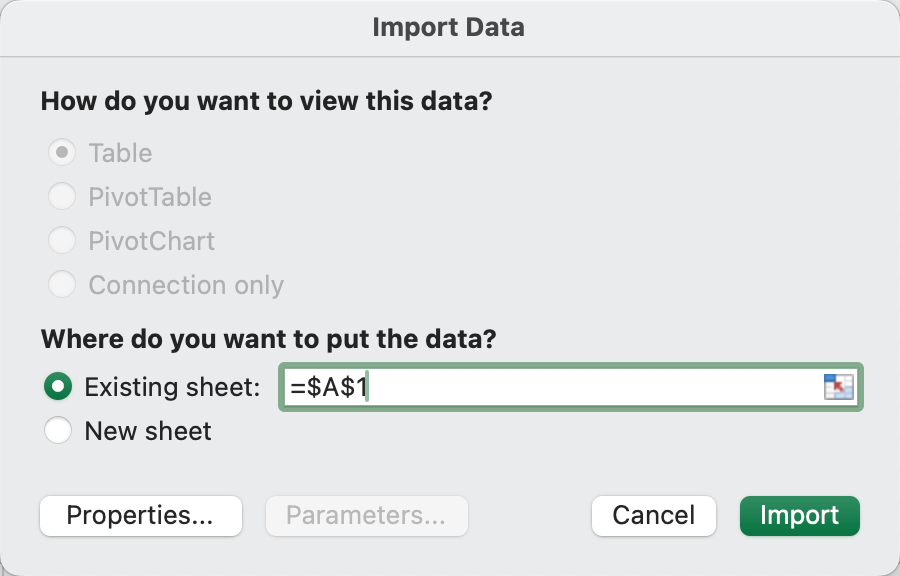
Opening TSV Files
TSV files and TXT files are tab delimited text files. Most computers default to opening TXT files in text editors, such as Microsoft Word or Notepad. If you click on your TSV file and it opens in a text editor, you can follow these steps to open the file in Excel instead.
Using “Open With…” to Open TSV Files with Excel
- Download your TSV file from Qualtrics.
- Navigate to the folder the file was saved in.
- Right-click on the file.
- Select Open With and select Excel.
- You can now use the file in Excel.
Text Import Into Microsoft Excel
Sometimes users may not have Open With as an option to select their default program for a file. In this case, you would want to follow the below steps.
- Download your TSV from Qualtrics. See Exporting Response Data for detailed instructions on downloading survey responses.
Qtip: You can technically download a TSV in many different places in Qualtrics, such as a mailing list or an employee participant list, but downloading response data is the most common example. Note that the pages linked in this Qtip may reference features only available in some licenses.
- Open Excel.
- Select File and Open.
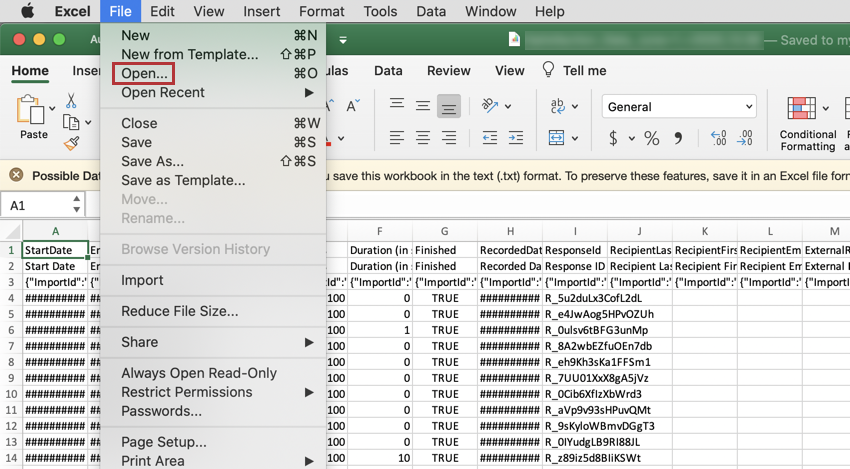
- Locate and select your file. Select Open.
- The Text Import Wizard will open. Select the Delimited file type and click Next.
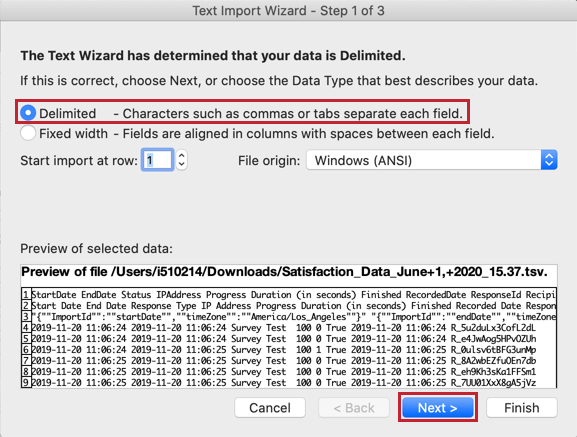
- On Step 2 of the Wizard, make sure the only delimiter selected is Tab.
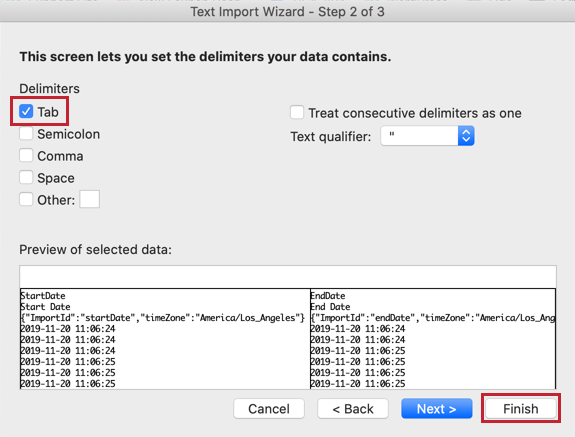
- On Step 3 of the Wizard, select Finish.
- Depending on your file and the version of Excel you’re using, you may be finished. Otherwise, the Import Data window may open and give you the choice to add the data into the Existing sheet or a New sheet.
- If you select Existing sheet, add $A$1 (which refers to the upper-left top cell) and click OK.
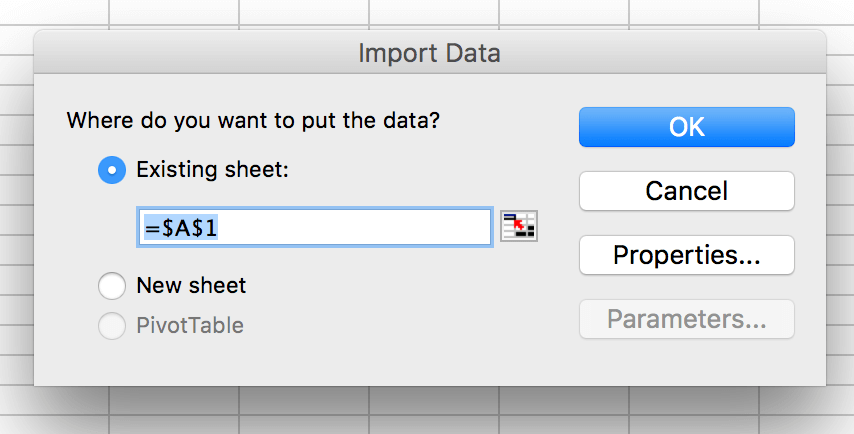
- You can now continue to work with the file in Excel.
Qtip: Make sure to set the file origin to UTF-8 so that characters import correctly.
Qtip: If you want Excel to read data in a certain format (e.g. dates), you can specify the data formatting in Step 3 of the Text Import Wizard. Look at the data preview in the bottom of the Text Import Wizard window. Select a column that needs formatting and choose the format in the top right. You have the option to choose General, Text or Date. You can repeat this step with several columns.
Qtip: If some of your data is displayed as “NAME?”, Excel detected a symbol (e.g. +) at the beginning of the data and assumed you are entering a formula. To fix this issue, select Text in Step 3 of the Text Import Wizard to display your data normally.
Setting Excel as the Default App for All TSV Files On Your Computer
Sometimes, even if you’ve already opened a TSV file in Excel, your computer will still try to open a text editor instead when you try to open a new TSV on your computer. If you find this happening to you, here’s how to resolve the issue by making Excel the default app for TSVs:
On Windows
- Find a TSV file on your computer. Do not double-click it or open it.
- Right-click on the TSV file.
- Click Open with.
- Select Choose an app.
- Select Always use this app to open .tsv files.
- Select Excel from the list of apps, or search for Excel if it’s not listed there.
- Click OK.
On a Mac
- Find a TSV file on your computer. Do not double-click it or open it.
- Right-click on the TSV file.
- Click Get Info.
- Select Open With.
- Select Excel from the list of apps, or search for Excel if it’s not listed there.
- Click Change All.
- Click Continue.

